NISSAN XTERRA 2002 WD22 / 1.G User Guide
Manufacturer: NISSAN, Model Year: 2002, Model line: XTERRA, Model: NISSAN XTERRA 2002 WD22 / 1.GPages: 263, PDF Size: 2.22 MB
Page 11 of 263
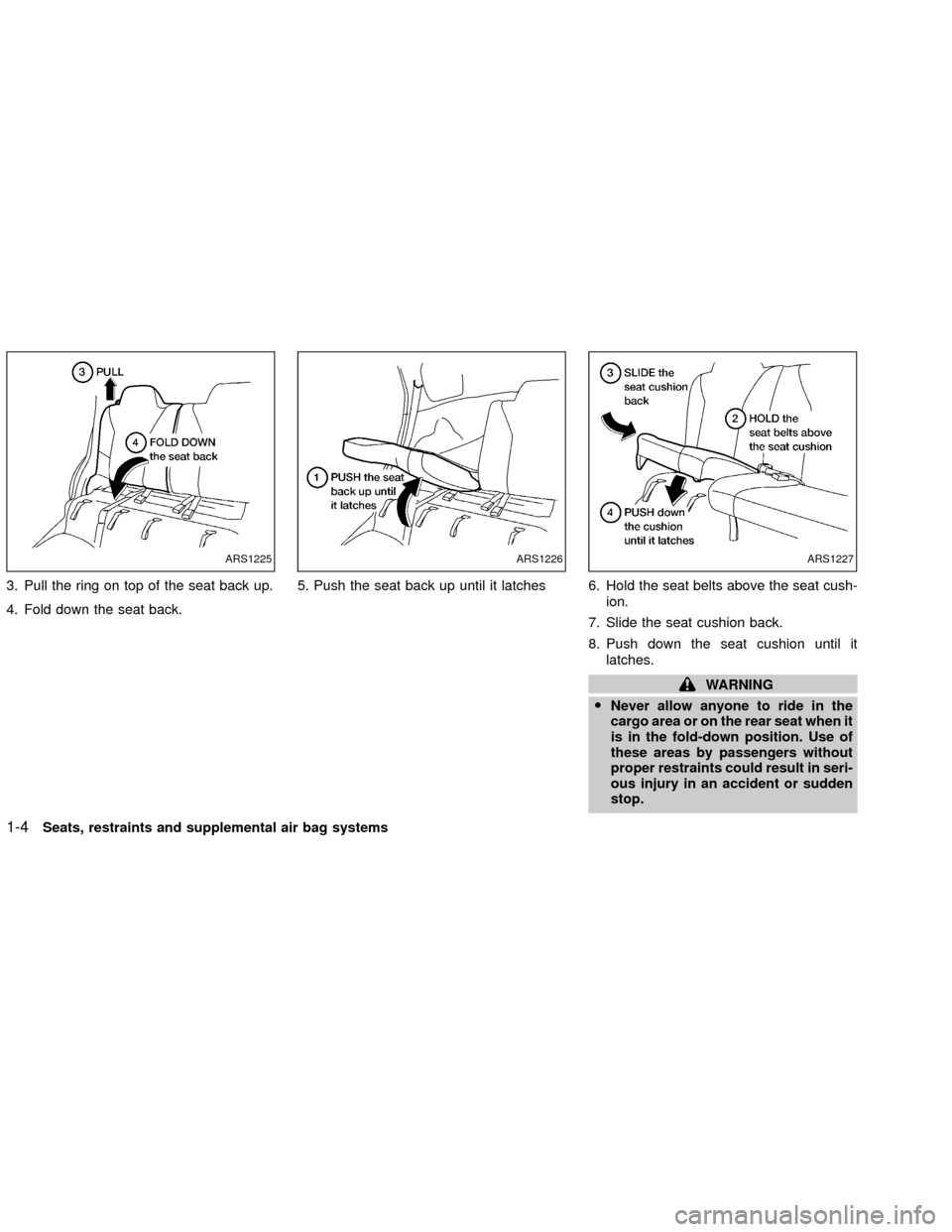
3. Pull the ring on top of the seat back up.
4. Fold down the seat back.5. Push the seat back up until it latches 6. Hold the seat belts above the seat cush-
ion.
7. Slide the seat cushion back.
8. Push down the seat cushion until it
latches.
WARNING
ONever allow anyone to ride in the
cargo area or on the rear seat when it
is in the fold-down position. Use of
these areas by passengers without
proper restraints could result in seri-
ous injury in an accident or sudden
stop.
ARS1225ARS1226ARS1227
1-4Seats, restraints and supplemental air bag systems
ZX
Page 12 of 263
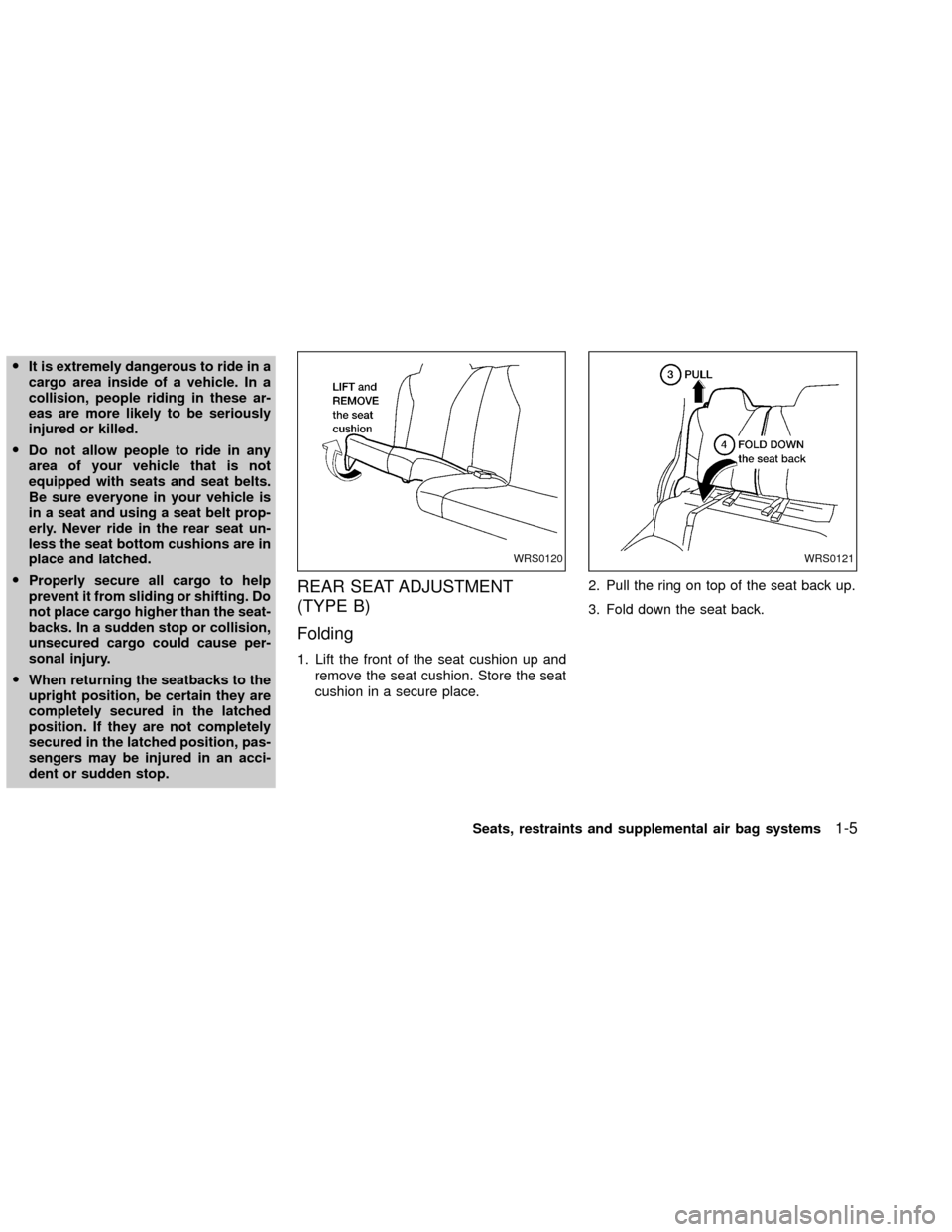
OIt is extremely dangerous to ride in a
cargo area inside of a vehicle. In a
collision, people riding in these ar-
eas are more likely to be seriously
injured or killed.
ODo not allow people to ride in any
area of your vehicle that is not
equipped with seats and seat belts.
Be sure everyone in your vehicle is
in a seat and using a seat belt prop-
erly. Never ride in the rear seat un-
less the seat bottom cushions are in
place and latched.
OProperly secure all cargo to help
prevent it from sliding or shifting. Do
not place cargo higher than the seat-
backs. In a sudden stop or collision,
unsecured cargo could cause per-
sonal injury.
OWhen returning the seatbacks to the
upright position, be certain they are
completely secured in the latched
position. If they are not completely
secured in the latched position, pas-
sengers may be injured in an acci-
dent or sudden stop.
REAR SEAT ADJUSTMENT
(TYPE B)
Folding
1. Lift the front of the seat cushion up and
remove the seat cushion. Store the seat
cushion in a secure place.2. Pull the ring on top of the seat back up.
3. Fold down the seat back.
WRS0120WRS0121
Seats, restraints and supplemental air bag systems1-5
ZX
Page 13 of 263
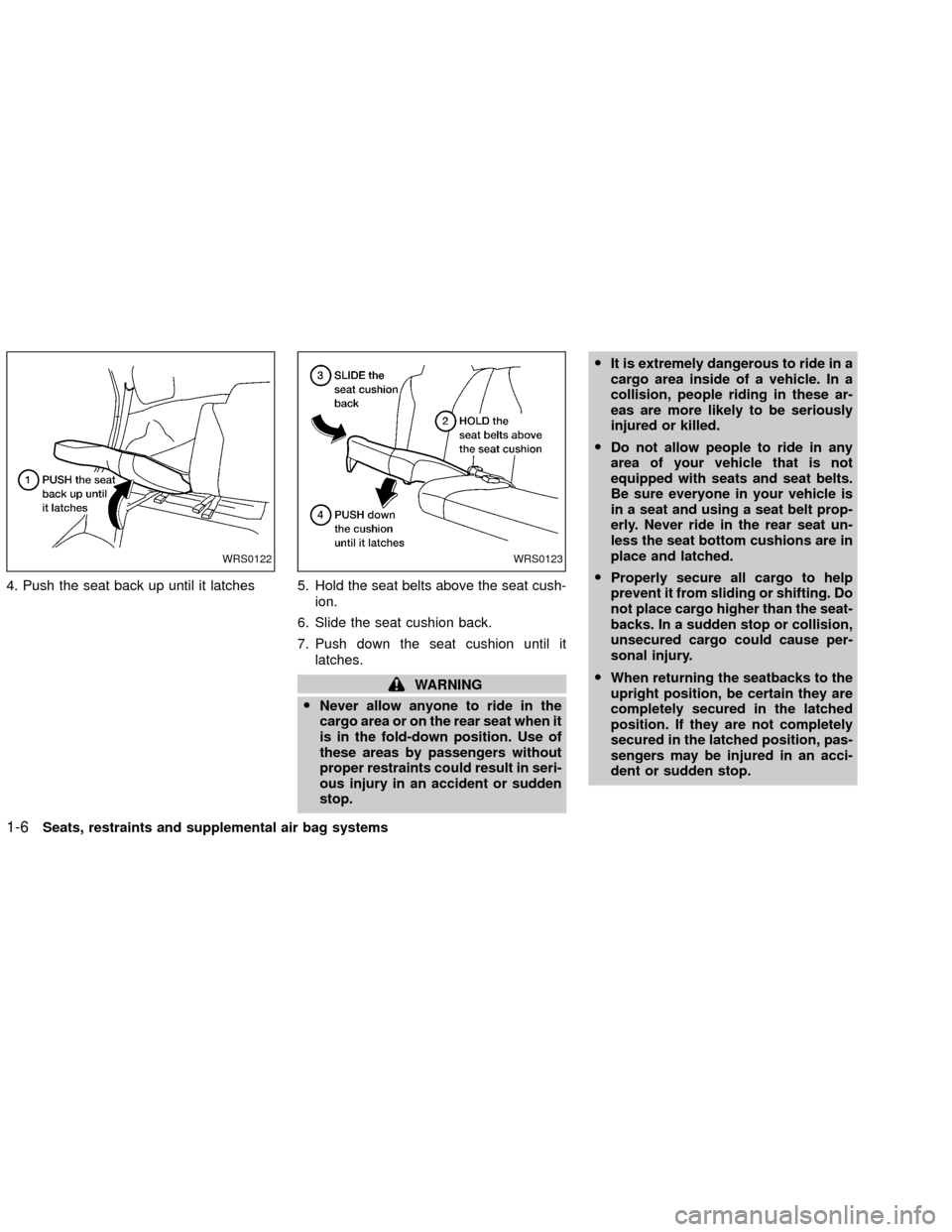
4. Push the seat back up until it latches 5. Hold the seat belts above the seat cush-
ion.
6. Slide the seat cushion back.
7. Push down the seat cushion until it
latches.
WARNING
ONever allow anyone to ride in the
cargo area or on the rear seat when it
is in the fold-down position. Use of
these areas by passengers without
proper restraints could result in seri-
ous injury in an accident or sudden
stop.OIt is extremely dangerous to ride in a
cargo area inside of a vehicle. In a
collision, people riding in these ar-
eas are more likely to be seriously
injured or killed.
ODo not allow people to ride in any
area of your vehicle that is not
equipped with seats and seat belts.
Be sure everyone in your vehicle is
in a seat and using a seat belt prop-
erly. Never ride in the rear seat un-
less the seat bottom cushions are in
place and latched.
OProperly secure all cargo to help
prevent it from sliding or shifting. Do
not place cargo higher than the seat-
backs. In a sudden stop or collision,
unsecured cargo could cause per-
sonal injury.
OWhen returning the seatbacks to the
upright position, be certain they are
completely secured in the latched
position. If they are not completely
secured in the latched position, pas-
sengers may be injured in an acci-
dent or sudden stop.
WRS0122WRS0123
1-6Seats, restraints and supplemental air bag systems
ZX
Page 14 of 263
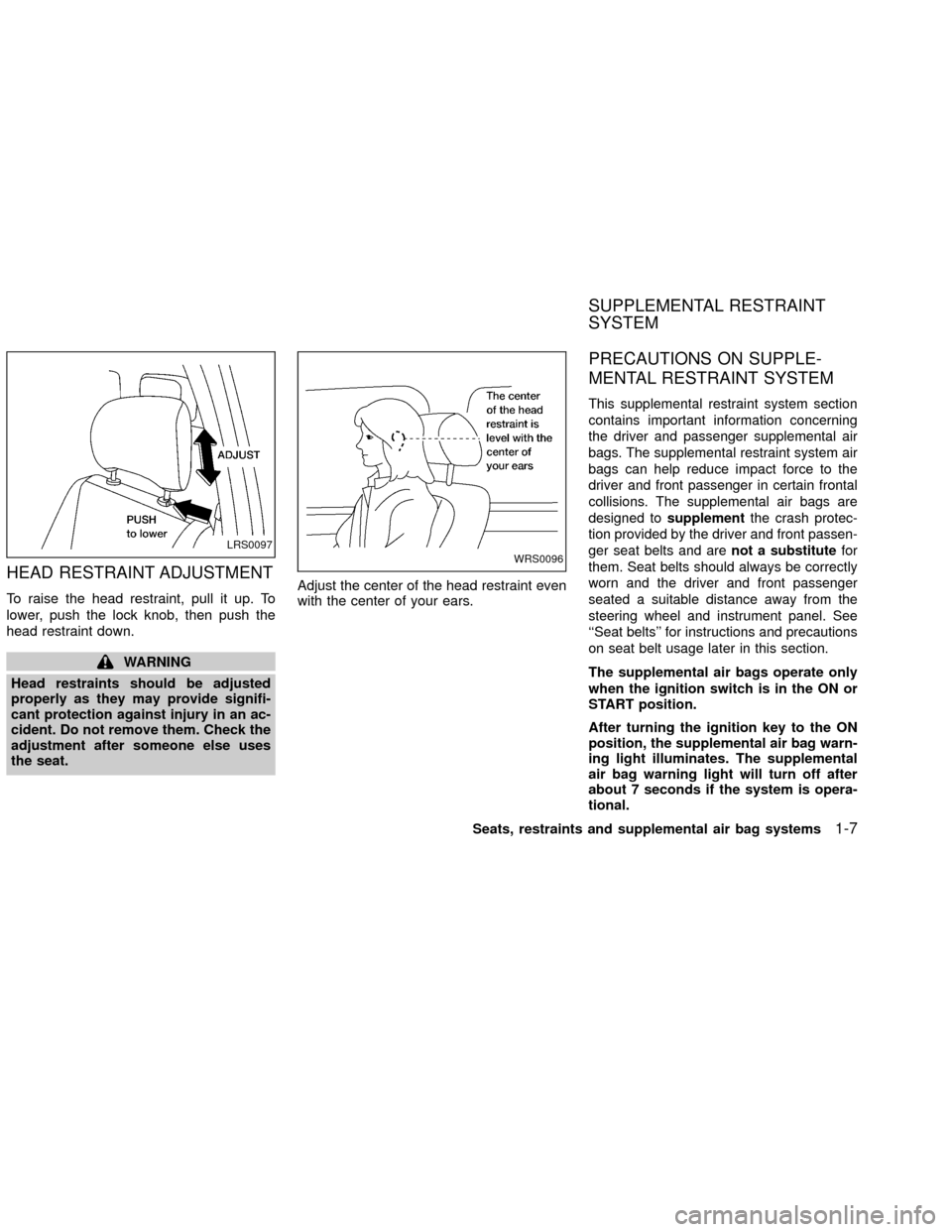
HEAD RESTRAINT ADJUSTMENT
To raise the head restraint, pull it up. To
lower, push the lock knob, then push the
head restraint down.
WARNING
Head restraints should be adjusted
properly as they may provide signifi-
cant protection against injury in an ac-
cident. Do not remove them. Check the
adjustment after someone else uses
the seat.Adjust the center of the head restraint even
with the center of your ears.
PRECAUTIONS ON SUPPLE-
MENTAL RESTRAINT SYSTEM
This supplemental restraint system section
contains important information concerning
the driver and passenger supplemental air
bags. The supplemental restraint system air
bags can help reduce impact force to the
driver and front passenger in certain frontal
collisions. The supplemental air bags are
designed tosupplementthe crash protec-
tion provided by the driver and front passen-
ger seat belts and arenot a substitutefor
them. Seat belts should always be correctly
worn and the driver and front passenger
seated a suitable distance away from the
steering wheel and instrument panel. See
``Seat belts'' for instructions and precautions
on seat belt usage later in this section.
The supplemental air bags operate only
when the ignition switch is in the ON or
START position.
After turning the ignition key to the ON
position, the supplemental air bag warn-
ing light illuminates. The supplemental
air bag warning light will turn off after
about 7 seconds if the system is opera-
tional.
LRS0097WRS0096
SUPPLEMENTAL RESTRAINT
SYSTEM
Seats, restraints and supplemental air bag systems1-7
ZX
Page 15 of 263
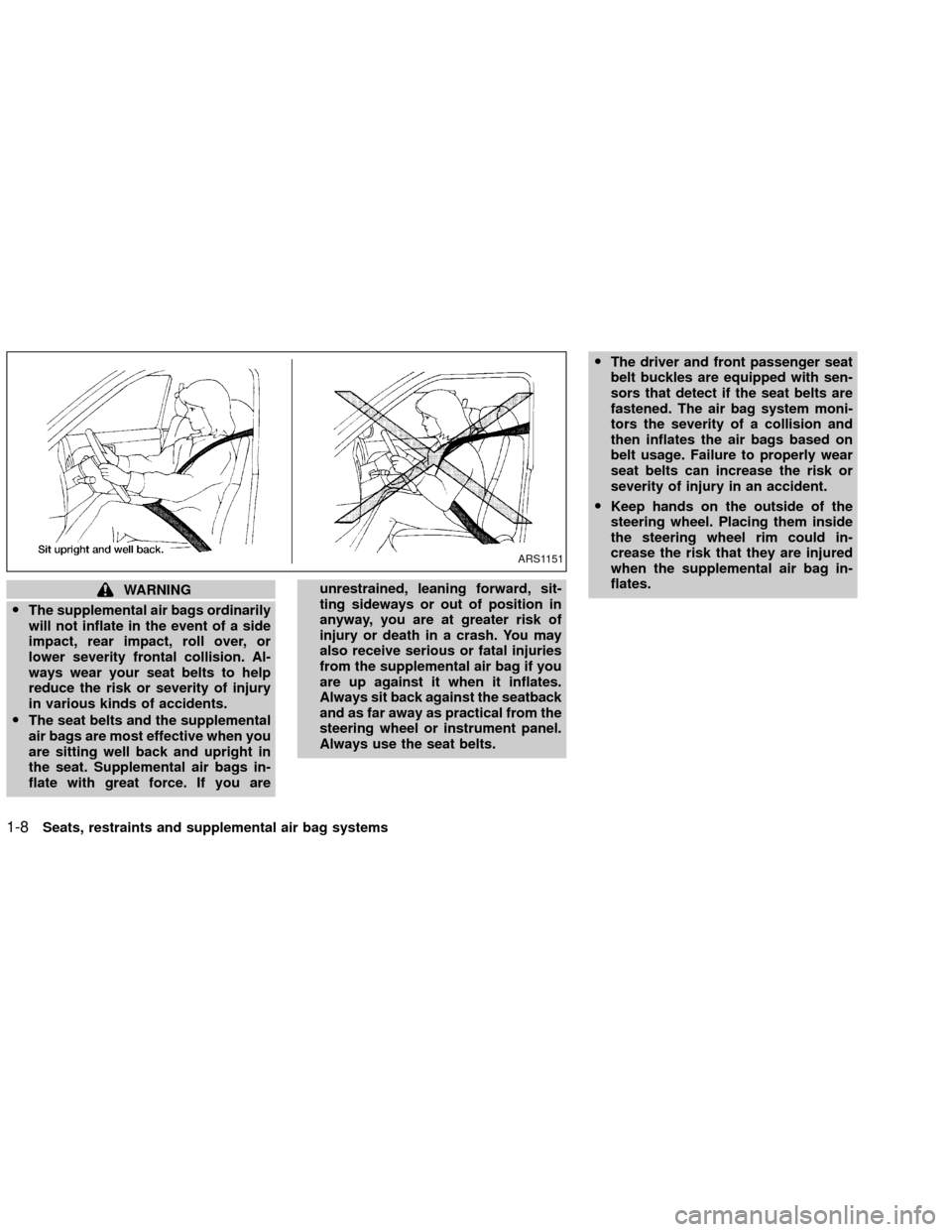
WARNING
OThe supplemental air bags ordinarily
will not inflate in the event of a side
impact, rear impact, roll over, or
lower severity frontal collision. Al-
ways wear your seat belts to help
reduce the risk or severity of injury
in various kinds of accidents.
OThe seat belts and the supplemental
air bags are most effective when you
are sitting well back and upright in
the seat. Supplemental air bags in-
flate with great force. If you areunrestrained, leaning forward, sit-
ting sideways or out of position in
anyway, you are at greater risk of
injury or death in a crash. You may
also receive serious or fatal injuries
from the supplemental air bag if you
are up against it when it inflates.
Always sit back against the seatback
and as far away as practical from the
steering wheel or instrument panel.
Always use the seat belts.OThe driver and front passenger seat
belt buckles are equipped with sen-
sors that detect if the seat belts are
fastened. The air bag system moni-
tors the severity of a collision and
then inflates the air bags based on
belt usage. Failure to properly wear
seat belts can increase the risk or
severity of injury in an accident.
OKeep hands on the outside of the
steering wheel. Placing them inside
the steering wheel rim could in-
crease the risk that they are injured
when the supplemental air bag in-
flates.
ARS1151
1-8Seats, restraints and supplemental air bag systems
ZX
Page 16 of 263

ARS1153ARS1041
ARS1042
Seats, restraints and supplemental air bag systems1-9
ZX
Page 17 of 263
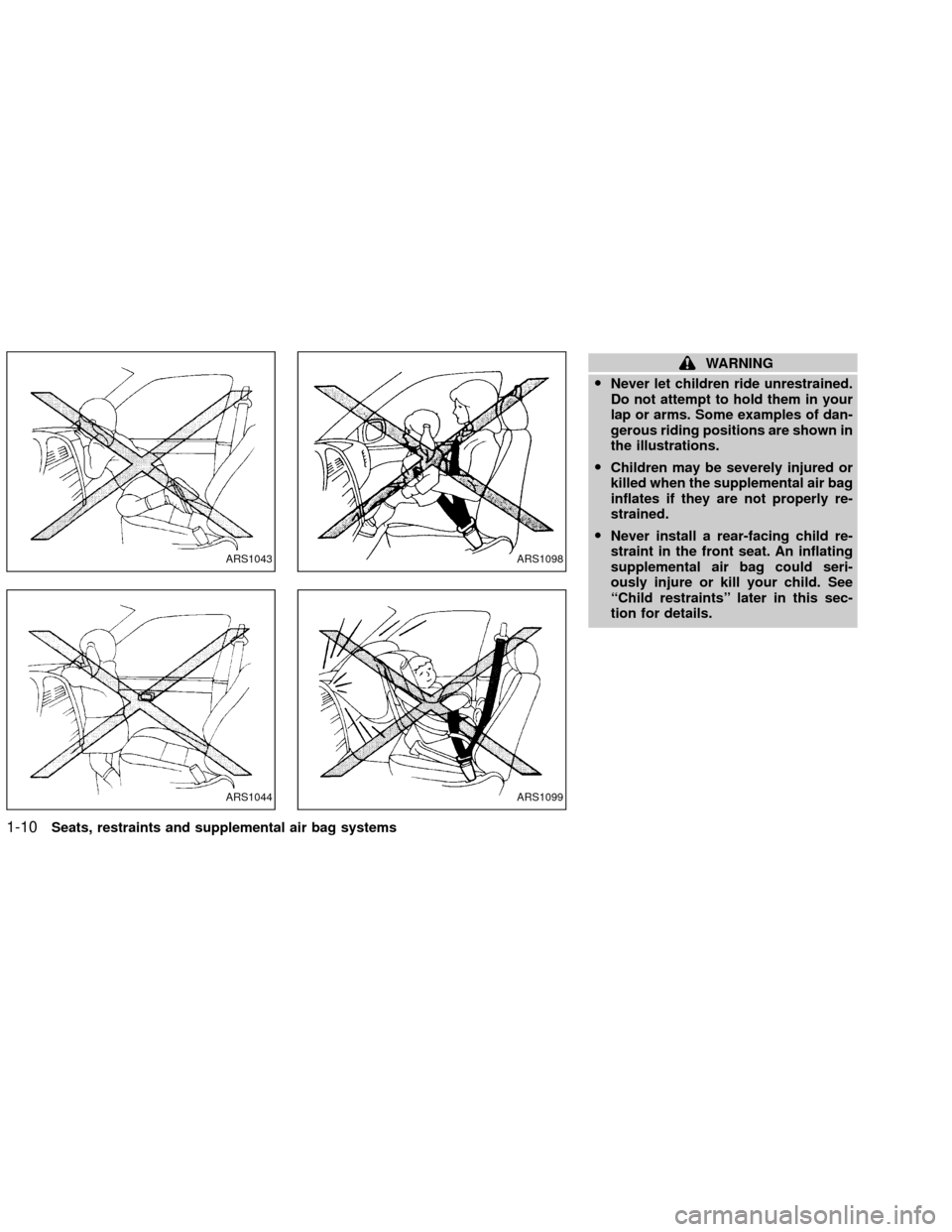
WARNING
ONever let children ride unrestrained.
Do not attempt to hold them in your
lap or arms. Some examples of dan-
gerous riding positions are shown in
the illustrations.
OChildren may be severely injured or
killed when the supplemental air bag
inflates if they are not properly re-
strained.
ONever install a rear-facing child re-
straint in the front seat. An inflating
supplemental air bag could seri-
ously injure or kill your child. See
``Child restraints'' later in this sec-
tion for details.
ARS1043
ARS1044
ARS1098
ARS1099
1-10Seats, restraints and supplemental air bag systems
ZX
Page 18 of 263

Supplemental air bag system
The driver supplemental air bag is located in
the center of the steering wheel. The pas-
senger supplemental air bag is located in
the top right section of the instrument panel.
These systems are designed to meet optional
certification requirements under U.S. regula-
tions. They are also permitted in Canada. The
optional certification allows air bags to be
designed to inflate somewhat less forcefully
than previously.However, all of the informa-tion, cautions and warnings in this manual
still apply and must be followed.
The supplemental air bag system is de-
signed to inflate in higher severity frontal
collisions, although it may inflate if the
forces in another type of collision are similar
to those of a higher severity frontal impact. It
may not inflate in certain frontal collisions.
Vehicle damage (or lack of it) is not always
an indication of proper supplemental air bag
system operation.
The supplemental air bag system has dual
stage inflators for both the driver and pas-
senger air bags. The system monitors infor-
mation from the crash zone sensor, the
diagnosis sensor unit and seat belt buckle
sensors that detect if the seat belts are
fastened. Inflator operation is based on the
severity of a collision and whether the seat
belts are being used.
When the supplemental air bag inflates, a
fairly loud noise may be heard, followed by
the release of smoke. This smoke is not
harmful and does not indicate a fire. Care
should be taken not to intentionally inhale it,
as it may cause irritation and choking.
Those with a history of a breathing condition
should get fresh air promptly.
WRS0119
Seats, restraints and supplemental air bag systems1-11
ZX
Page 19 of 263
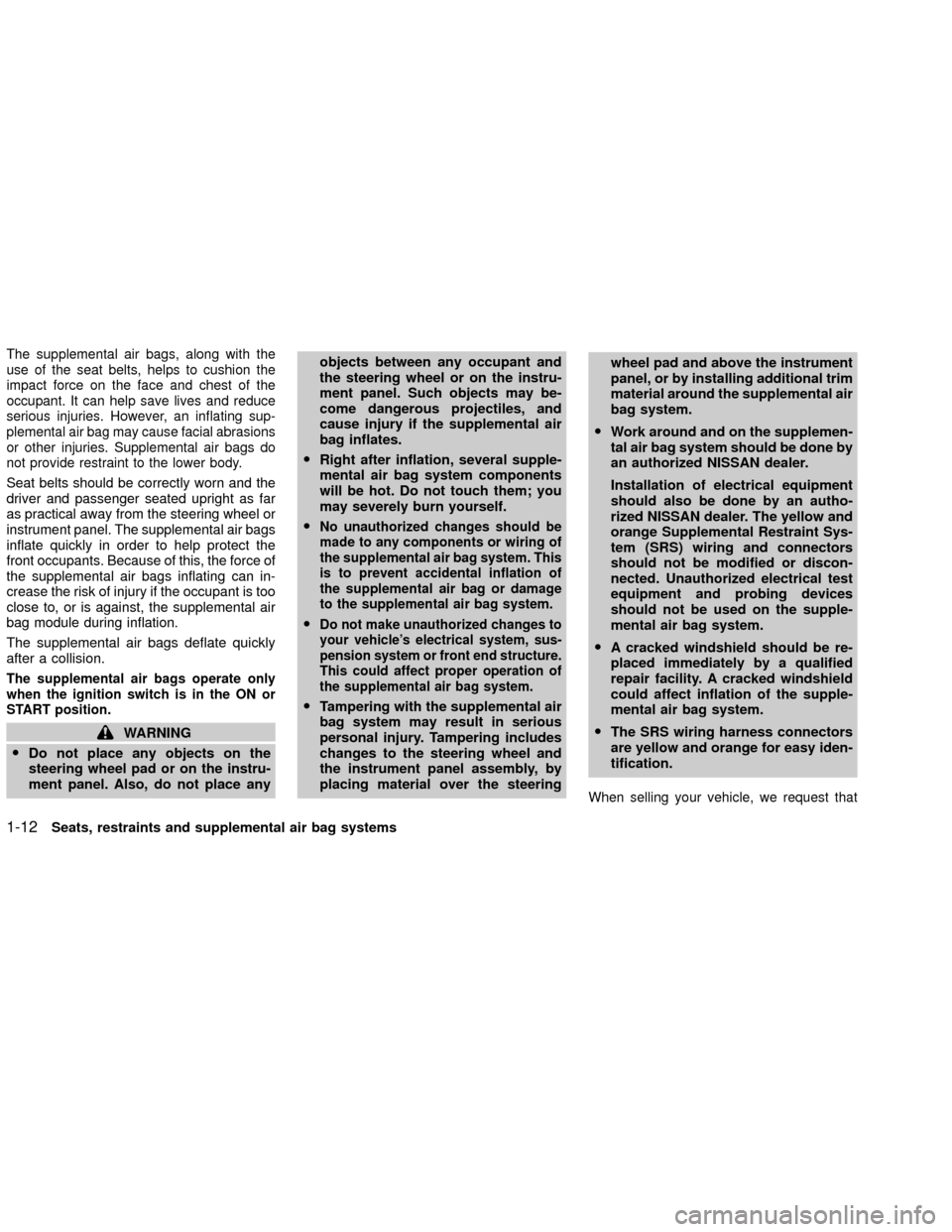
The supplemental air bags, along with the
use of the seat belts, helps to cushion the
impact force on the face and chest of the
occupant. It can help save lives and reduce
serious injuries. However, an inflating sup-
plemental air bag may cause facial abrasions
or other injuries. Supplemental air bags do
not provide restraint to the lower body.
Seat belts should be correctly worn and the
driver and passenger seated upright as far
as practical away from the steering wheel or
instrument panel. The supplemental air bags
inflate quickly in order to help protect the
front occupants. Because of this, the force of
the supplemental air bags inflating can in-
crease the risk of injury if the occupant is too
close to, or is against, the supplemental air
bag module during inflation.
The supplemental air bags deflate quickly
after a collision.
The supplemental air bags operate only
when the ignition switch is in the ON or
START position.
WARNING
ODo not place any objects on the
steering wheel pad or on the instru-
ment panel. Also, do not place anyobjects between any occupant and
the steering wheel or on the instru-
ment panel. Such objects may be-
come dangerous projectiles, and
cause injury if the supplemental air
bag inflates.
ORight after inflation, several supple-
mental air bag system components
will be hot. Do not touch them; you
may severely burn yourself.
O
No unauthorized changes should be
made to any components or wiring of
the supplemental air bag system. This
is to prevent accidental inflation of
the supplemental air bag or damage
to the supplemental air bag system.
ODo not make unauthorized changes to
your vehicle's electrical system, sus-
pension system or front end structure.
This could affect proper operation of
the supplemental air bag system.
OTampering with the supplemental air
bag system may result in serious
personal injury. Tampering includes
changes to the steering wheel and
the instrument panel assembly, by
placing material over the steeringwheel pad and above the instrument
panel, or by installing additional trim
material around the supplemental air
bag system.
OWork around and on the supplemen-
tal air bag system should be done by
an authorized NISSAN dealer.
Installation of electrical equipment
should also be done by an autho-
rized NISSAN dealer. The yellow and
orange Supplemental Restraint Sys-
tem (SRS) wiring and connectors
should not be modified or discon-
nected. Unauthorized electrical test
equipment and probing devices
should not be used on the supple-
mental air bag system.
OA cracked windshield should be re-
placed immediately by a qualified
repair facility. A cracked windshield
could affect inflation of the supple-
mental air bag system.
OThe SRS wiring harness connectors
are yellow and orange for easy iden-
tification.
When selling your vehicle, we request that
1-12Seats, restraints and supplemental air bag systems
ZX
Page 20 of 263
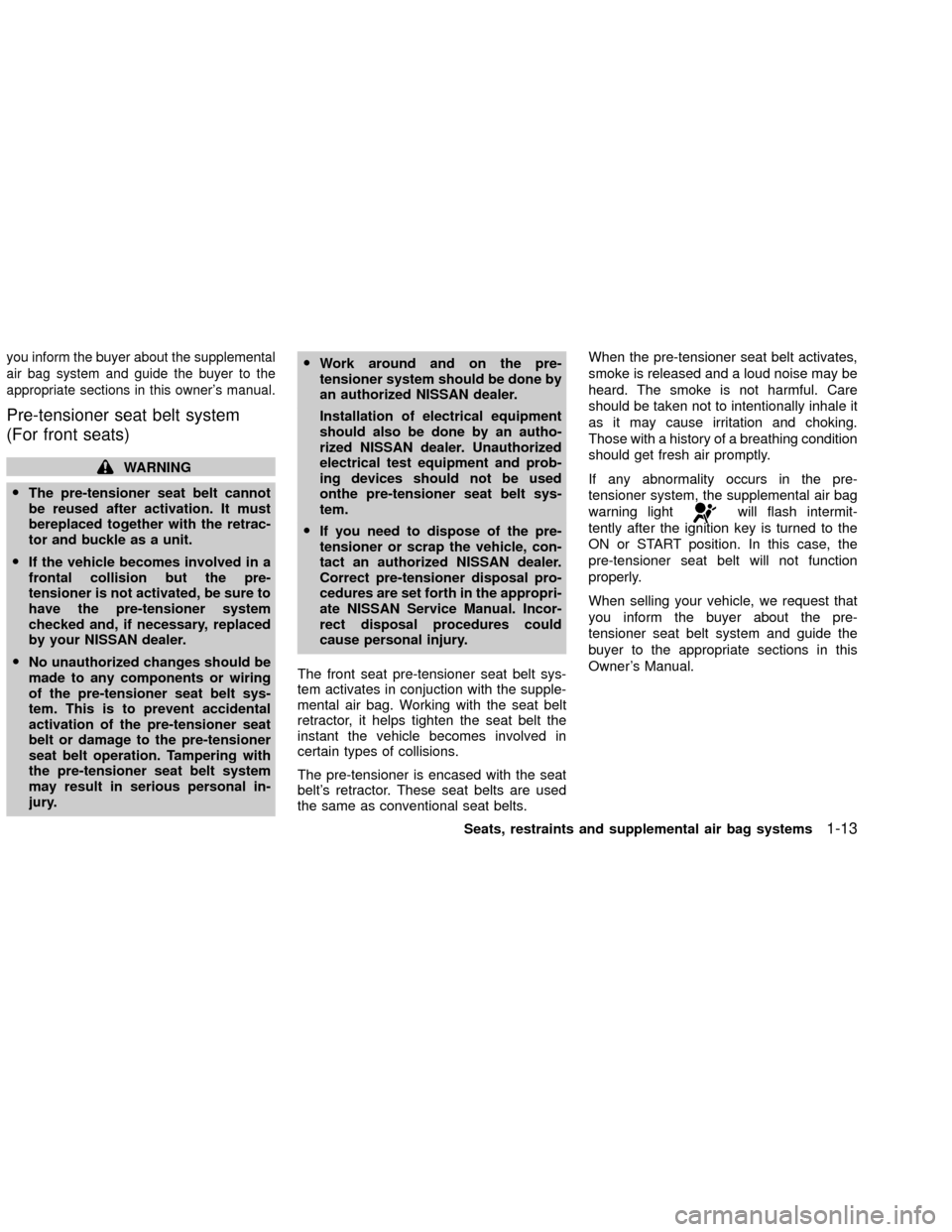
you inform the buyer about the supplemental
air bag system and guide the buyer to the
appropriate sections in this owner's manual.
Pre-tensioner seat belt system
(For front seats)
WARNING
OThe pre-tensioner seat belt cannot
be reused after activation. It must
bereplaced together with the retrac-
tor and buckle as a unit.
OIf the vehicle becomes involved in a
frontal collision but the pre-
tensioner is not activated, be sure to
have the pre-tensioner system
checked and, if necessary, replaced
by your NISSAN dealer.
ONo unauthorized changes should be
made to any components or wiring
of the pre-tensioner seat belt sys-
tem. This is to prevent accidental
activation of the pre-tensioner seat
belt or damage to the pre-tensioner
seat belt operation. Tampering with
the pre-tensioner seat belt system
may result in serious personal in-
jury.OWork around and on the pre-
tensioner system should be done by
an authorized NISSAN dealer.
Installation of electrical equipment
should also be done by an autho-
rized NISSAN dealer. Unauthorized
electrical test equipment and prob-
ing devices should not be used
onthe pre-tensioner seat belt sys-
tem.
OIf you need to dispose of the pre-
tensioner or scrap the vehicle, con-
tact an authorized NISSAN dealer.
Correct pre-tensioner disposal pro-
cedures are set forth in the appropri-
ate NISSAN Service Manual. Incor-
rect disposal procedures could
cause personal injury.
The front seat pre-tensioner seat belt sys-
tem activates in conjuction with the supple-
mental air bag. Working with the seat belt
retractor, it helps tighten the seat belt the
instant the vehicle becomes involved in
certain types of collisions.
The pre-tensioner is encased with the seat
belt's retractor. These seat belts are used
the same as conventional seat belts.When the pre-tensioner seat belt activates,
smoke is released and a loud noise may be
heard. The smoke is not harmful. Care
should be taken not to intentionally inhale it
as it may cause irritation and choking.
Those with a history of a breathing condition
should get fresh air promptly.
If any abnormality occurs in the pre-
tensioner system, the supplemental air bag
warning light
will flash intermit-
tently after the ignition key is turned to the
ON or START position. In this case, the
pre-tensioner seat belt will not function
properly.
When selling your vehicle, we request that
you inform the buyer about the pre-
tensioner seat belt system and guide the
buyer to the appropriate sections in this
Owner's Manual.
Seats, restraints and supplemental air bag systems
1-13
ZX